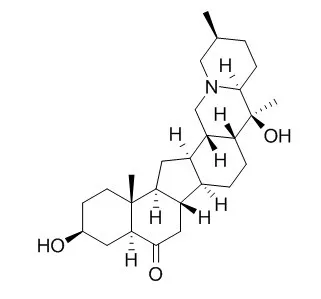| Structure Identification: |
| Yao Xue Xue Bao. 2010 Dec;45(12):1541-4. | | [Simultaneous determination of peimisine and sipeimine in Fritillaria walujewii regel and Fritillaria pallidiflora Schrenk by UPLC-ELSD].[Pubmed: 21351494] | The paper reports the establishment of a method for simultaneous determination of peimisine and Sipeimine contents in Fritillaria walujewii Regel and Fritillaria pallidiflora Schrenk.
METHODS AND RESULTS:
The analyses were performed on an ultra-performance liquid chromatography with evaporative light scattering detection (UPLC-ELSD), equipped with a binary solvent manager, a sampler manager and a column compartment, and connected to Waters Empower 2 software. An Acquity UPLC BEH C18 column (100 mm x 2.1 mm, 1.7 microm) was used for all analysis. The investigated compounds were separated with gradient mobile phase consisting of acetonitrile-0.02% triethylamine-water. The temperature of sample manager was set at 25 degrees C. Drift tube temperature was 40 degrees C, and spray parameter was 40% with injection volume of 1 microL. The investigated compounds including peimisine and Sipeimine had good linearity (r > or = 0.9991) over the tested ranges. The average recovery was 94.5% and 98.1% with RSD < or = 2.36%.
CONCLUSIONS:
The UPLC-ELSD method is simple, sensitive and accurate with good repeatability, which is available for quality control of F. walujewii Regel and F. pallidiflora Schrenk. | | Z Naturforsch C. 2008 Nov-Dec;63(11-12):789-93. | | Sipeimine-producing endophytic fungus isolated from Fritillaria ussuriensis.[Pubmed: 19227824] |
METHODS AND RESULTS:
Ten strains of endophytic fungi were isolated from the bulbs of the traditional Chinese medicinal plant Fritillaria ussuriensis. The extract from one of them, Fu7, showed a positive reaction with Dragendorff's reagent and the same Rf value in thin-layer chromatography (TLC) analysis as authentic Sipeimine. A further TLC scan and high-performance liquid chromatography-evaporative light-scattering detection (HPLC-ELSD) showed that one ingredient of the extract of strain Fu7 had a similar absorption curve in the range 200-700 nm and the same retention time as authentic Sipeimine.
CONCLUSIONS:
Thus, the fungus produces the bioactive ingredient Sipeimine, as does its host plant, and could be used for the production of Sipeimine by fermentation. |
|






 Cell. 2018 Jan 11;172(1-2):249-261.e12. doi: 10.1016/j.cell.2017.12.019.IF=36.216(2019)
Cell. 2018 Jan 11;172(1-2):249-261.e12. doi: 10.1016/j.cell.2017.12.019.IF=36.216(2019) Cell Metab. 2020 Mar 3;31(3):534-548.e5. doi: 10.1016/j.cmet.2020.01.002.IF=22.415(2019)
Cell Metab. 2020 Mar 3;31(3):534-548.e5. doi: 10.1016/j.cmet.2020.01.002.IF=22.415(2019) Mol Cell. 2017 Nov 16;68(4):673-685.e6. doi: 10.1016/j.molcel.2017.10.022.IF=14.548(2019)
Mol Cell. 2017 Nov 16;68(4):673-685.e6. doi: 10.1016/j.molcel.2017.10.022.IF=14.548(2019)